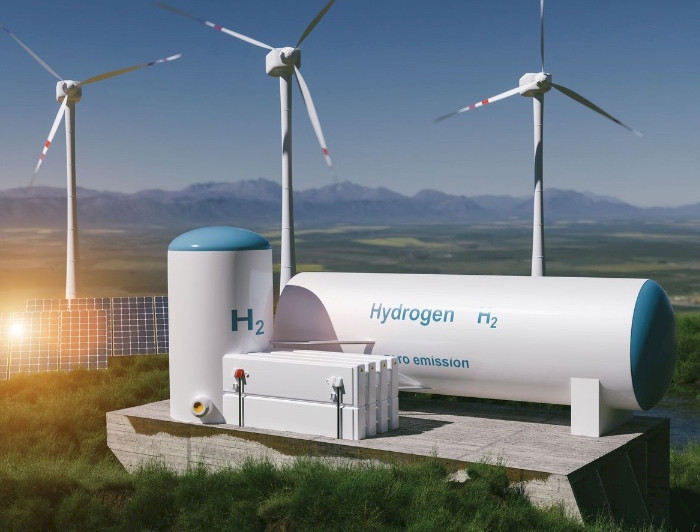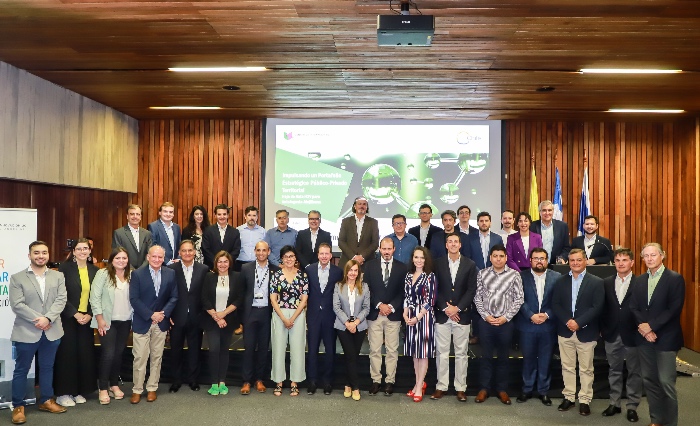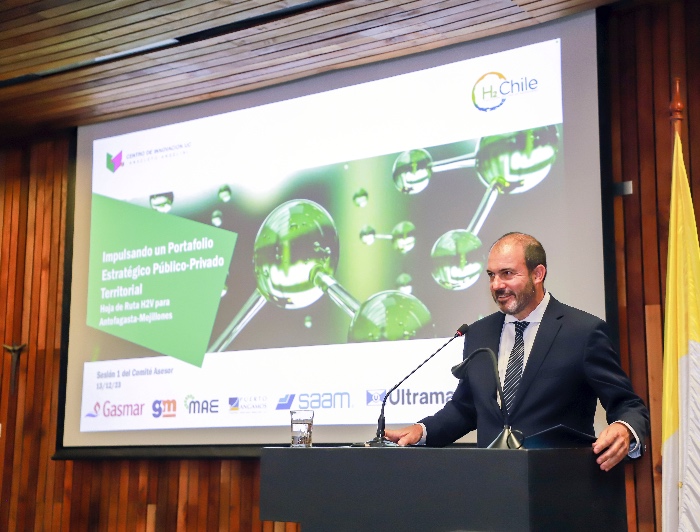
Boosting Chile's Green Hydrogen Revolution
Key representatives from the public, private, and academic sectors, in collaboration with active participation from the UC Chile, have come together to establish an advisory committee, tasked with crafting a roadmap for the sustainable development of Green Hydrogen, aimed at bolstering renewable energy in the country.

photo_camera The advisory committee's initial step is to collect data on local and national initiatives and projects that are impacting the Mejillones area. This information will be used by implementation committees to create a four-year portfolio of initiatives. (Photo by: iStock Photo)
Regarded as the future of energy, green hydrogen is produced without generating polluting emissions, making it environmentally sustainable. Given that hydrogen is the most abundant chemical element on Earth, constituting 75% of matter, it is proposed as a key energy vector for accomplishing global decarbonization.
To build a portfolio of projects to foster the development of hydrogen valleys in Chile, the initiative “Promoting a Strategic Public-Private Territorial Portfolio: Green Hydrogen Roadmap (H2V) for Antofagasta-Mejillones” was established. It is led by the UC Anacleto Angelini Innovation Center and the Chilean Hydrogen Association, H2 Chile, with the support of the Mankuk consulting firm. The initiative achieved a significant milestone by hosting its first advisory committee meeting at the UC Innovation Center.
During the meeting, an in-depth analysis of the current scenario in the northern part of the country was conducted, addressing the development needed for the generation of green hydrogen. The event was attended by Ramón Molina, executive director of the UC Innovation Center, who presided as chair; Marcos Kulka, executive director of the Chilean Hydrogen Association; H2 Chile, as co-chair; Mankuk, in a supportive capacity; and prominent public and private actors from various industries.
According to Ramón Molina, they will focus on the hydrogen valley in the northern region, specifically Mejillones and Antofagasta. The objective is to unveil its characteristics, identify gaps and challenges, and conclude with the publication of a publicly accessible document that will facilitate the transfer and dissemination of the diagnosis along with a portfolio of implementable projects.
At the core of this advisory committee is forging robust connections among diverse stakeholders committed to advancing green hydrogen generation. The committee boasts representation from key entities such as the Ministry of Energy; the Ministry of Economy, Development, and Tourism; Corfo; The Senate and Chamber of Deputies; the Municipality of Mejillones; the Industrial Association of Mejillones; the Energy Development Center of Antofagasta; GASMAR/Grupo Arroyo; Generadora Metropolitana; H2 Antofagasta; Hinicio; MAE VOLTA; Puerto Angamos; SAAM Terminals; Sernageomin; Ultramar; Universidad Católica del Norte; and UC Chile.

UC Chile Participation
Vice President for Research Pedro Bouchon has strongly promoted the work of the Roadmaps, which have considered issues that represent complex challenges of our society, such as population aging and digital transformation, which he led together with Sergio Rademacher, who was the general manager of Microsoft Chile, giving rise to the Cybersecurity Roadmap.
"Engaging university experts in this multidisciplinary committee is part of the essential work we do, emphasizing the promotion of innovation and the transfer of knowledge to society. We aim to foster multi-sectoral initiatives to cultivate collective and consensus-driven perspectives, exemplified by the Roadmap. Our objective is to contribute to the nation's development and growth in an area that captivates the attention of many nations. Chile possesses competitive advantages that position it favorably to emerge as a key global player," stated Vice President Bouchon.
Members of UC Chile who sit on the committee include the Dean of the Faculty of Engineering, Loreto Valenzuela; Professor Álvaro Videla from the Energy Center; the Dean of the Faculty of Chemistry and Pharmacy, Mario Aranda; Professor René Rojas; and Juan Eduardo Ibáñez from the UC Law School.
“I think it is highly significant that the Faculty of Chemistry and Pharmacy is included, as within our research field, we focus on crucial aspects of hydrogen. Moreover, we house a MIGA Millennium Institute as a hydrogen vector and a vector for its storage and transport. We have experts in the field committed to ensuring that industry development aligns with community progress. Drawing lessons from past mistakes, we aim to learn, avoid repetition, and establish an industry that evolves in tandem with community development," stated Dean Mario Aranda.
The Dean of the School of Engineering, Loreto Valenzuela, highlights the School's active engagement in green hydrogen research and training across various departments and centers. Academic experts in the field will contribute their diverse expertise to the Roadmap and support the advisory committee in identifying implementation obstacles, discovering synergies and opportunities, and designing a pre-competitive project portfolio. This portfolio aims to mitigate and distribute risks while expediting the development of green hydrogen in the region.
Renewable hydrogen is set to play a pivotal role in decarbonizing various sectors. The efforts concentrated on the hydrogen valley in the northern region, specifically Mejillones, and Antofagasta, will be crucial in meeting the global target of limiting global warming to below 1.5 °C, as stipulated by the Paris Agreement, signed by our country. This agreement mandates a reduction of approximately 45% in emissions by 2030, with the ultimate goal of achieving zero net emissions by 2050.
"As academics, we need to contribute by bringing attention to the comprehensive process, rather than solely focusing on the green hydrogen production itself. To achieve this, we must cultivate advanced and qualified human capital because the country deserves development in this field, beyond the integration of technology. I am hopeful that there will be fundamental development in the use of hydrogen in the country, and this experience, these results, will enable us to consider exports and other opportunities," expressed Professor Rene Rojas from the Faculty of Chemistry and Pharmacy.
According to the Dean of Engineering, the roadmap should guarantee that the green hydrogen industry benefits all stakeholders. This entails creating job opportunities and fostering economic development for the local population. Simultaneously, it should attract investments to enhance infrastructure and improve the quality of life for Mejillones residents. It's crucial to remember that H2V plants are chemical plants, so their location should be carefully planned and defined within the context of a territorial development plan.
Work in the Field

The first tangible step of this advisory committee involves assessing ongoing local and/or national initiatives and projects that have an impact on the Mejillones area. The committee will then formulate development strategies based on these findings. Following this, the Implementation Committee will focus on the identified key areas, establishing a portfolio of initiatives projected over four years.
This committee will deliberate on strategic aspects within the value chain, including topics such as territorial planning and management, shared critical infrastructure, physical and environmental safety, community development, retention of specialized talent, R&D&I strategy, and technology transfer, among other considerations.
According to Marcos Kulka, the Executive Director of the Chilean Hydrogen Association (H2 Chile) and co-chair of the project, "Green hydrogen will account for a 24% reduction in emissions in Chile and 15% globally. The unique advantages of Mejillones, including its existing infrastructure, ports, pipelines, and access routes, along with the presence of an industrial park actively involved in hydrogen-related activities and derivatives, such as facilities for handling ammonia, create a significant opportunity. The expectation is to source ammonia locally from the production of green ammonia, rather than continuing to import it.” “This is an opportunity to create local value by generating new opportunities for productive chains and addressing the needs and expectations of the communities."
Meanwhile, José Miguel Benavente, the Executive Vice President of Corfo, expressed his appreciation for the work initiated in the first session. "Corfo is not only excited about participating in the green hydrogen committee; it also aligns with our vision. This involves, firstly, a public policy that originates from local communities, moving from the territory to the center. Secondly, green hydrogen is viewed as a means for decarbonizing Chile. Lastly, it's seen as an opportunity to create jobs, foster knowledge, establish new industries, and fundamentally contribute to improving not just economic indicators but also social development,” he remarked.
Dean Mario Aranda also emphasized the social component, stating, "We need inclusive growth where all sectors engage in dialogue. The benefit of this roundtable is its ability to comprehensively assess impacts. This is the only approach that allows us to formulate a project with robust guidelines, ensuring that no one is excluded. Exclusion can lead to biases in assessing sustainability issues."
Moreover: "We have the opportunity to excel due to our natural surroundings, making us competitive. The regions in the north, with abundant solar panels, and in the south, with exceptionally strong winds, provide us with the capability to harness clean energy. This energy, which we can control and store, will enable us to produce hydrogen.
The next step is establishing efficient transportation mechanisms. For transportation, we leverage our extensive 4,300 km coastline and well-sized ports, providing us with ample options for efficient transportation. This is why I firmly believe that, in collaboration with nature, private entities, public stakeholders, and academia, we are compelled to make this successful. With all the favorable conditions in place, we are unquestionably required to be competitive.
The advisory committee is scheduled to meet again in March 2024, while the work of the implementation committees will take place between April and August of this year, to have the Green Hydrogen Roadmap with all the proposals by next September.
Considering the upcoming tasks, Professor René Rojas emphasizes the significance of "thoroughly understanding global developments in this field to avoid errors, given the substantial costs involved." Constructive collaboration is key. If each entity openly shares its knowledge, needs, and expectations, with direct follow-up, it will be greatly beneficial.
In response to this analysis, the Dean, Loreto Valenzuela, suggests that "by 2050, Antofagasta could attract an investment of $70 billion for the design and development of the Green Hydrogen Valley. Linked to this progress, a positive influence on employment rates and job diversification is expected, which could further support the mining industry in accomplishing its decarbonization goals.


